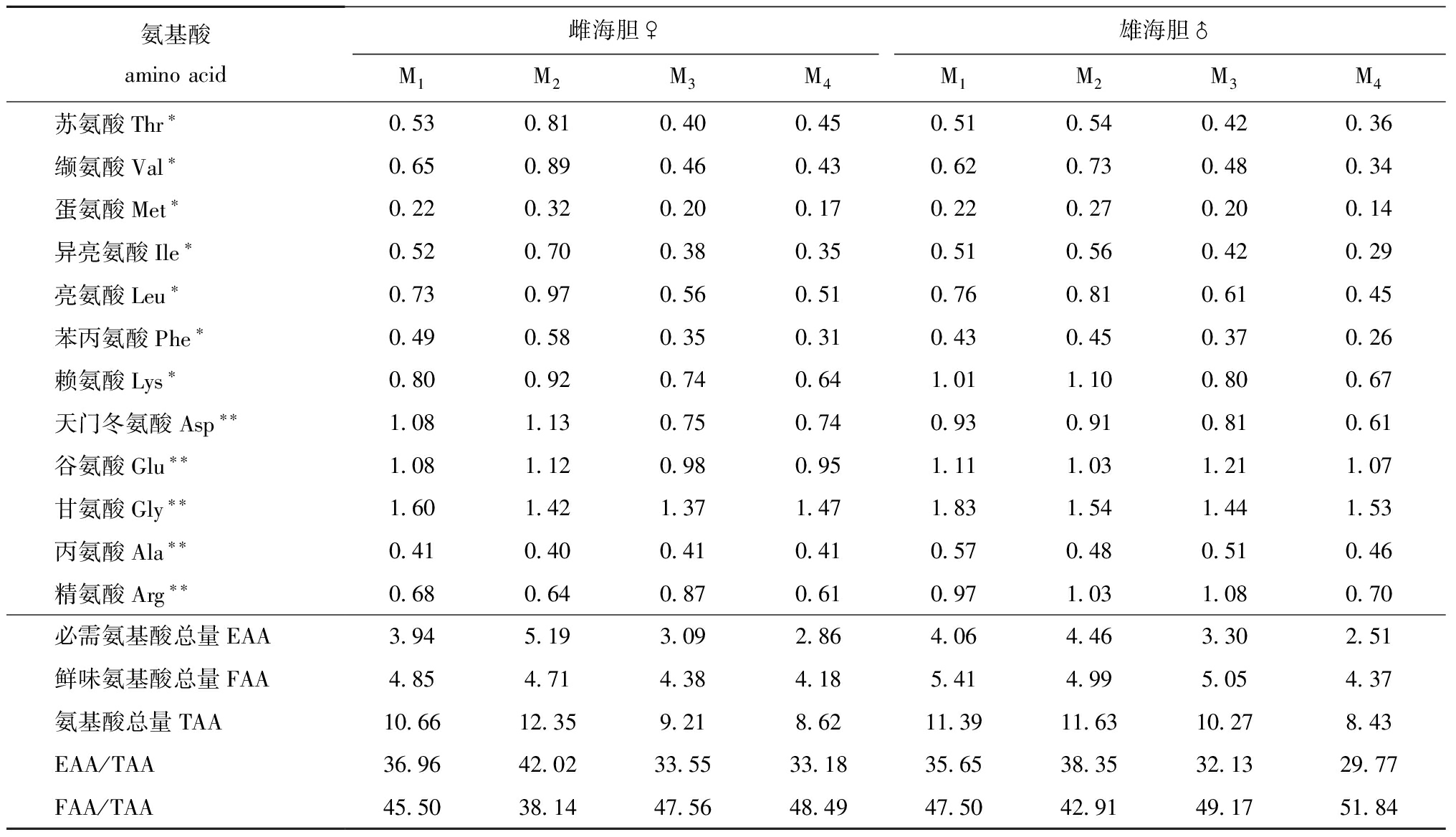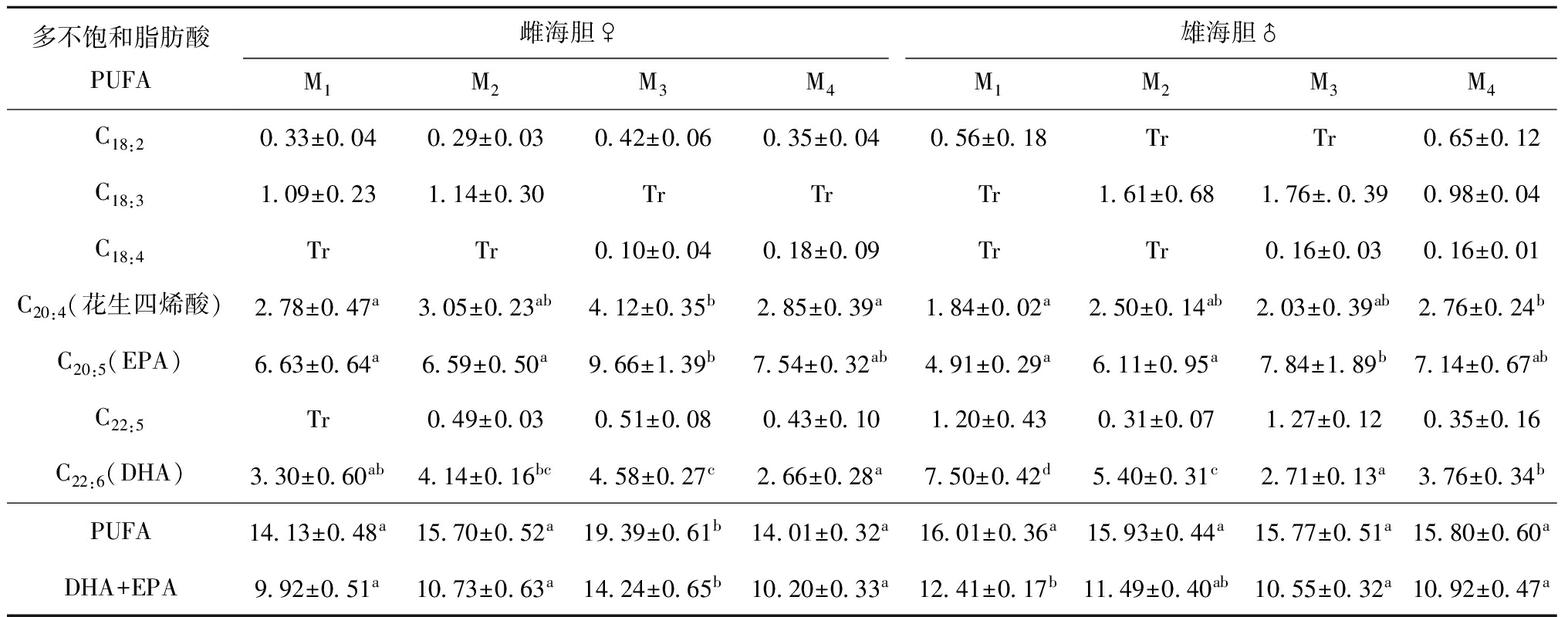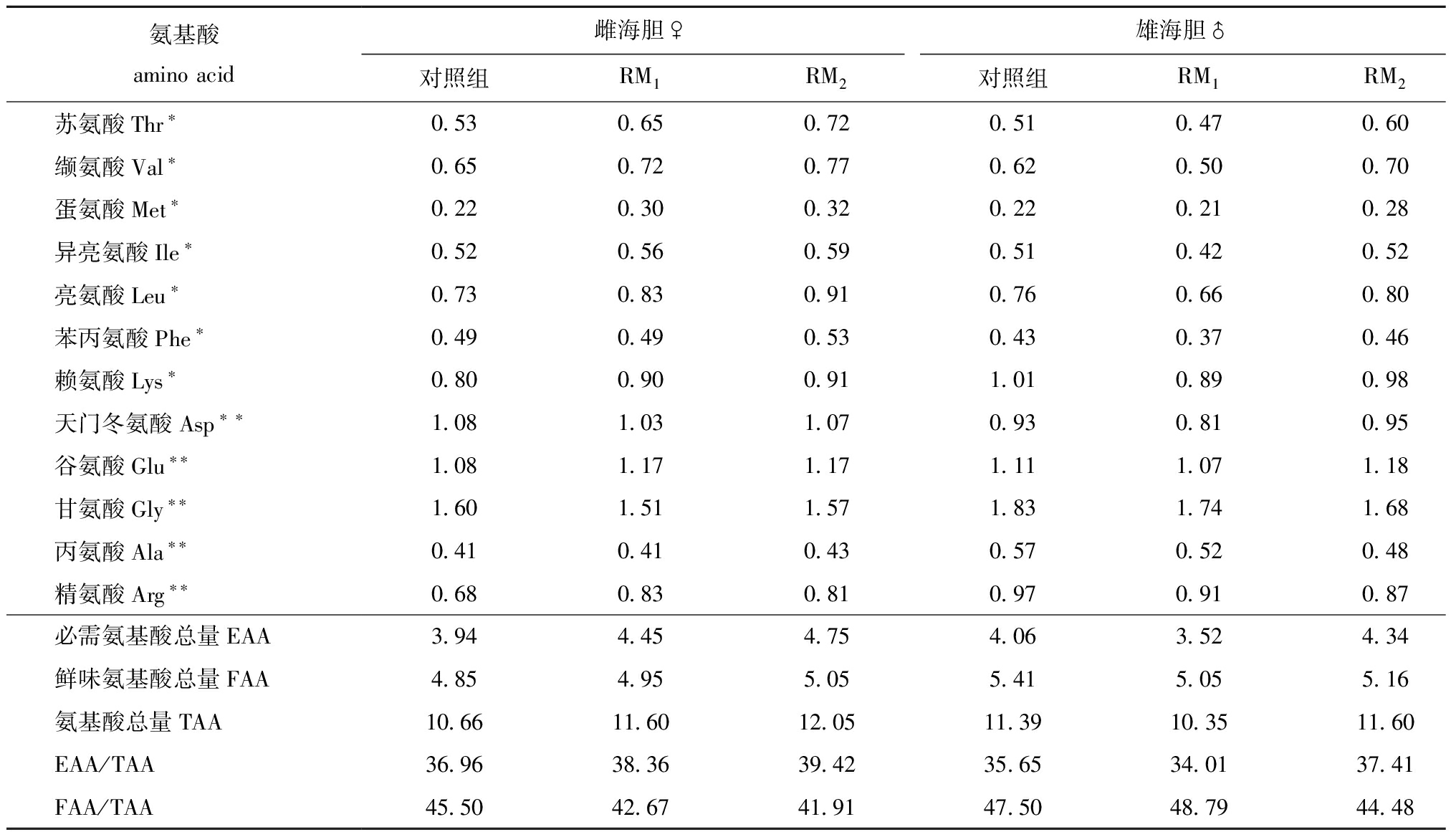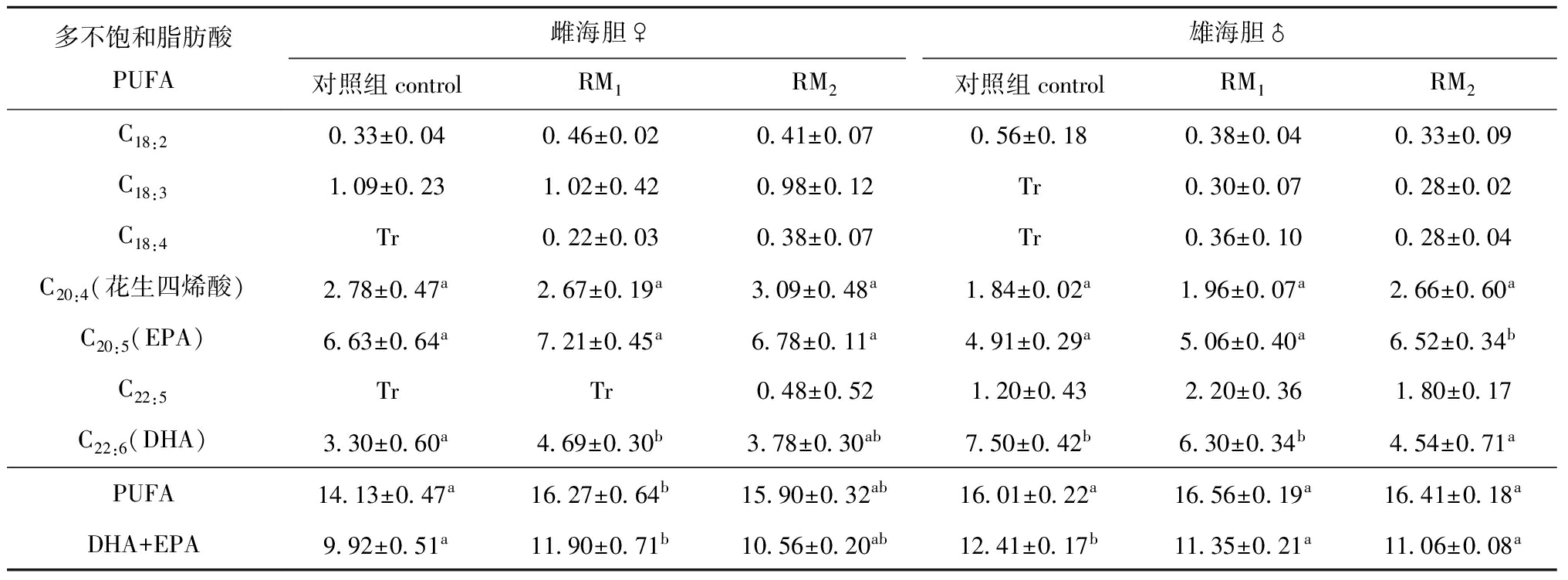不同饵料模式与投喂方式对中间球海胆性腺营养成分的影响
丁玉龙,丁君,丁文君,常亚青
(大连海洋大学 农业部北方海水增养殖重点实验室,辽宁 大连 116023)
摘要:在实验室条件下,进行了不同饵料模式与投喂方式对中间球海胆Strongylocentrotusintermedius性腺营养成分的影响研究。试验设置4种饵料模式(M1组投喂海带,M2组投喂海带+贻贝,M3组投喂南瓜,M4组投喂胡萝卜)和3种投喂方式(对照组投喂海带150 d,RM1组投喂南瓜75 d后投喂海带75 d,RM2组投喂胡萝卜75 d后投喂海带75 d),试验结束后,对海胆性腺中氨基酸、β-胡萝卜素和脂肪酸含量进行测定。结果表明:不同饵料模式条件下,M2组海胆性腺中氨基酸总量(TAA)、必需氨基酸总量(EAA)和EAA/TAA均最高;M4组鲜味氨基酸总量占氨基酸总量的百分比最高;M1与M2组雌、雄海胆的β-胡萝卜素含量及个体平均β-胡萝卜素含量均无差异性差异(P>0.05),二者显著高于其他2组(P<0.05);M3组雌海胆性腺中多不饱和脂肪酸(PUFA)含量显著高于其他3组(P<0.05),雄海胆中PUFA含量4组间无显著性差异(P>0.05)。不同投喂方式条件下,RM2组海胆性腺中TAA、EAA和EAA/TAA含量均最高;对照组雄海胆性腺中β-胡萝卜素含量及个体平均β-胡萝卜素含量均显著高于RM1和RM2组(P<0.05),而雌海胆性腺中二者的含量与RM1组无显著性差异(P>0.05),但均显著高于RM2组(P<0.05);RM1组雌、雄海胆性腺中PUFA含量均最高。研究表明:M2组饵料模式和RM2组投喂方式均可提高海胆性腺中氨基酸含量,且M2组饵料模式对海胆个体平均β-胡萝卜素含量的提高有促进作用,M3组饵料模式和RM1组投喂方式可明显提高海胆性腺中PUFA的含量。
关键词:中间球海胆;氨基酸;β-胡萝卜素;脂肪酸
中间球海胆Strongylocentrotusintermedius又称虾夷马粪海胆,1989年由大连海洋大学从日本引入中国,因其性腺饱满、品质上佳,深受消费者喜爱。中间球海胆作为中国主要的水产养殖品种之一,其性腺中富含氨基酸、β-胡萝卜素和ω-3族、ω-6族多不饱和脂肪酸,是一种营养价值和药用价值较高的海洋经济生物。氨基酸作为维持生命活动的重要物质,不仅具有重要的生理功能,而且在食物呈味上发挥重要作用[1]。海胆性腺中的β-胡萝卜素含量与性腺的色泽直接相关,不仅能改善海胆性腺的颜色和品质[2-3],还可以提高动物非特异免疫机能[4],在动物营养和生理功能方面发挥重要作用。脂肪酸作为海胆性腺中主要的营养成分,不仅可以促进海胆的胚胎发育及幼体早期发育[5],而且对人类心血管疾病等有较好的防治效果[6-7]。饵料是影响海胆性腺发育的重要因素[8-9],研究不同饵料模式和投喂方式对海胆性腺中氨基酸、β-胡萝卜素和脂肪酸积累规律的影响对指导中间球海胆健康养殖及利用具有一定意义。
目前,有关海胆性腺的研究主要集中在海胆性腺营养成分及营养代谢等方面。Liyana-Pathirana等[10]、Kaneko等[11]研究了季节变化和人工饲料对海胆性腺中氨基酸组成及口味的影响。Osako等[12]研究了紫海胆Anthocidariscrassispina性腺发育过程中游离氨基酸组成的差异。王丽梅等[13]研究了中间球海胆性腺氨基酸的组成。McBride等[3]研究了β-胡萝卜素在巨紫球海胆S.franciscanus体内的吸收和积累以及食物中β-胡萝卜素含量对性腺颜色的影响。Suckling等[14]研究了人工饲料对海胆性腺颜色及生物量的影响。González-Durán等[15]研究了饵料中脂质含量对绿海胆S.droebachiensis性腺中脂肪酸组成及脂类代谢的影响。Castell等[16]研究了饵料中脂质对绿海胆稚胆脂肪酸组成及脂类代谢的影响。Cook等[17]、Barberá等[18]对海胆性腺中脂肪酸组成进行了研究分析。
海带作为海胆的主要饵料,受其分布和生长周期的限制,饵料成本较高,在很大程度上制约了海胆养殖业的发展。南瓜、胡萝卜富含类胡萝卜素,价格低廉且易于获得,以南瓜、胡萝卜为饵料,进行海胆营养成分的研究目前尚未见报道。本研究在前期预试验的基础上,以南瓜、胡萝卜替代海带作为海胆饵料,研究了不同饵料及投喂方式对中间球海胆氨基酸、β-胡萝卜素和脂肪酸含量的影响,以期找到提高海胆性腺中氨基酸、β-胡萝卜素和脂肪酸含量的饵料模式和投喂方式,为海胆的健康养殖提供一定的参考。
1材料与方法
1.1材料
试验用海胆为农业部北方海水增养殖重点实验室培育的2龄健康中间球海胆,壳径为(46.57±1.87)mm,体质量为(44.27±4.91)g。
1.2方法
1.2.1 试验设计
(1)饵料模式试验。试验设4种模式:M1(对照)组投喂海带,M2组投喂海带+贻贝(比例约2∶1),M3组投喂南瓜,M4组投喂胡萝卜。试验周期为150 d。
(2)投喂方式试验。试验设3种模式: 对照组投喂海带150 d,RM1组投喂南瓜75 d后投喂海带75 d;RM2组投喂胡萝卜75 d后投喂海带75 d。
每组试验均设3个重复,每个重复10枚海胆,共计180枚。
试验开始前将试验海胆于实验室暂养一周。整个试验过程中保持各组环境条件与养殖密度相同,试验期间,水温为12.47~19.01 ℃,pH为8.06±0.10,过量投喂。试验时间为2012年12月16日—2013年5月15日。
1.2.2 取样与测量 试验结束时,解剖各试验组海胆并测量其性腺营养成分指标。
氨基酸含量委托谱尼测试科技股份有限公司进行测定,在每种饵料模式和投喂方式下分别测定雌、雄海胆性腺混合样品中氨基酸的含量;采用分光光度法测定β-胡萝卜素含量[19];参照GB5413.27—2010中的方法测定脂肪酸含量;参照沈妍等[20]的方法测定一般营养成分含量。
个体平均β-胡萝卜素含量的计算公式为
个体平均β-胡萝卜素含量(mg)=β-胡萝卜素含量(mg/100g)×个体平均性腺湿质量(g)。
1.3数据处理
利用SPSS 19.0软件,分别以不同饵料模式和投喂方式为影响因素,对各测量数据作单因素方差分析,并对不同饵料模式及投喂方式间的差异作Duncan多重比较,显著性水平设为0.05。
2结果与分析
2.1不同饵料模式对中间球海胆性腺营养成分及氨基酸、β-胡萝卜素、脂肪酸含量的影响
2.1.1 一般营养成分 从表1可见:M3、M4组海胆性腺的总糖含量显著高于M1、M2组(P<0.05);M1、M2组的水分含量显著高于M3、M4组(P<0.05);性腺中粗蛋白质、粗脂肪和灰分含量在4种饵料模式间均有显著性差异(P<0.05),M2组的粗蛋白质粗脂肪和灰分含量均最高。
表1不同饵料对中间球海胆性腺一般营养成分含量的影响(以鲜基计)
Tab.1EffectsofdifferentdietsontheapproximatecompositioningonadofseaurchinStrongylocentrotusintermedius
w/%

饵料模式feedingmodels总糖totalsugar水分moisture灰分ash粗蛋白质crudeprotein粗脂肪crudefatM1(对照)0 25±0 01a73 99±0 58b0 98±0 01a13 86±0 03c4 72±0 01cM20 22±0 01a74 30±0 52b1 81±0 01d14 55±0 01d5 46±0 03dM30 45±0 02b69 16±0 58a1 32±0 05b11 96±0 01b3 92±0 03aM40 65±0 02c71 15±0 57a1 70±0 02c9 66±0 03a4 42±0 01b
注:同列中标有不同小写字母者表示组间有显著性差异(P<0.05),标有相同小写字母者表示组间无显著性差异(P>0.05),下同
Note:The means with different letters within the same column are significant differences at the 0.05 probability level, and the means with the same letters within the same column are not significant differences, et sequentia
2.1.2 氨基酸含量 本研究中,以测定的16种氨基酸总量作为蛋白质氨基酸的相对总量。
从表2可见:雌、雄海胆性腺中氨基酸总量(TAA)和必需氨基酸总量(EAA)均为M2组最高,M4组最低;雌、雄海胆性腺中EAA占16种TAA的百分比(EAA/TAA)均为M2组最高,M4组最低,且雌性高于雄性;雌、雄海胆性腺中鲜味氨基酸(FAA)含量均为M1组最高,M4组最低,且雄性高于雌性;雌、雄海胆性腺中FAA/TAA均为M4组最高,M2组最低;4种饵料模式下海胆性腺中氨基酸含量均为甘氨酸最高。
表2不同饵料对中间球海胆性腺中氨基酸含量的影响
Tab.2EffectsofdifferentdietsonthecontentsofaminoacidingonadofseaurchinStrongylocentrotusintermedius%

氨基酸aminoacid雌海胆♀雄海胆♂M1M2M3M4M1M2M3M4苏氨酸Thr∗0 530 810 400 450 510 540 420 36缬氨酸Val∗0 650 890 460 430 620 730 480 34蛋氨酸Met∗0 220 320 200 170 220 270 200 14异亮氨酸Ile∗0 520 700 380 350 510 560 420 29亮氨酸Leu∗0 730 970 560 510 760 810 610 45苯丙氨酸Phe∗0 490 580 350 310 430 450 370 26赖氨酸Lys∗0 800 920 740 641 011 100 800 67天门冬氨酸Asp∗∗1 081 130 750 740 930 910 810 61谷氨酸Glu∗∗1 081 120 980 951 111 031 211 07甘氨酸Gly∗∗1 601 421 371 471 831 541 441 53丙氨酸Ala∗∗0 410 400 410 410 570 480 510 46精氨酸Arg∗∗0 680 640 870 610 971 031 080 70必需氨基酸总量EAA3 945 193 092 864 064 463 302 51鲜味氨基酸总量FAA4 854 714 384 185 414 995 054 37氨基酸总量TAA10 6612 359 218 6211 3911 6310 278 43EAA/TAA36 9642 0233 5533 1835 6538 3532 1329 77FAA/TAA45 5038 1447 5648 4947 5042 9149 1751 84
注:*表示必需氨基酸,**表示鲜味氨基酸,下同
Note:*denotes essential amino acids,**denotes flavor amino acids,et sequentia
2.1.3 β-胡萝卜素含量及个体平均β-胡萝卜素含量 从图1可见,雌海胆性腺中M2组的β-胡萝卜素含量最高,为(0.022 01±0.001 41)%,与M1组无显著性差异(P>0.05),二者均显著高于其他两组(P<0.05);雄海胆性腺中M1组β-胡萝卜素含量最高,为(0.025 94±0.007 39)%,与M2组无显著性差异(P>0.05),二者均显著高于其他2组(P<0.05)。
从图1还可见:雌海胆中M2组个体平均β-胡萝卜素含量最高,为(4.66±0.38)mg,与M1组无显著性差异(P>0.05),二者均显著高于其他2组(P<0.05);雄海胆中M2组个体平均β-胡萝卜素含量最高,为(5.03±0.64)mg,与M1组无显著性差异(P>0.05),二者均显著高于其他2组(P<0.05)。
2.1.4 多不饱和脂肪酸含量 从表3可见:雌海胆性腺中M3组多不饱和脂肪酸(PUFA)含量显著高于其他3组(P<0.05),雄海胆性腺中PUFA含量在4组间均无显著性差异(P>0.05);雌海胆性腺中M3组DHA+EPA含量显著高于其他3组(P<0.05),雄海胆中M1组DHA+EPA含量最高,显著高于M3、M4组(P<0.05);雌、雄海胆性腺中M3组EPA含量均显著高于M1、M2组(P<0.05);雌海胆性腺中M3组DHA含量最高,M4组最低,二者有显著性差异(P<0.05),雄海胆中M1组DHA含量最高,且4组间均有显著性差异(P<0.05)。
2.2不同投喂方式对中间球海胆性腺营养成分及氨基酸、β-胡萝卜素、脂肪酸含量的影响
2.2.1 一般营养成分 从表4可见:对照组总糖含量显著低于RM1和RM2组(P<0.05);水分含量3组间无显著性差异(P>0.05);粗蛋白质及灰分含量3组间有显著性差异(P<0.05),且RM1组蛋白质含量最高;对照组粗脂肪含量与RM1组无显著性差异(P>0.05),二者均显著高于RM2组(P<0.05)。
表3不同饵料对中间球海胆性腺中多不饱和脂肪酸含量的影响
Tab.3EffectsofdifferentdietsonthecontentofPUFAingonadofseaurchinStrongylocentrotusintermedius%

多不饱和脂肪酸PUFA雌海胆♀雄海胆♂M1M2M3M4M1M2M3M4C18:20 33±0 040 29±0 030 42±0 060 35±0 040 56±0 18TrTr0 65±0 12C18:31 09±0 231 14±0 30TrTrTr1 61±0 681 76± 0 390 98±0 04C18:4TrTr0 10±0 040 18±0 09TrTr0 16±0 030 16±0 01C20:4(花生四烯酸)2 78±0 47a3 05±0 23ab4 12±0 35b2 85±0 39a1 84±0 02a2 50±0 14ab2 03±0 39ab2 76±0 24bC20:5(EPA)6 63±0 64a6 59±0 50a9 66±1 39b7 54±0 32ab4 91±0 29a6 11±0 95a7 84±1 89b7 14±0 67abC22:5Tr0 49±0 030 51±0 080 43±0 101 20±0 430 31±0 071 27±0 120 35±0 16C22:6(DHA)3 30±0 60ab4 14±0 16bc4 58±0 27c2 66±0 28a7 50±0 42d5 40±0 31c2 71±0 13a3 76±0 34bPUFA14 13±0 48a15 70±0 52a19 39±0 61b14 01±0 32a16 01±0 36a15 93±0 44a15 77±0 51a15 80±0 60aDHA+EPA9 92±0 51a10 73±0 63a14 24±0 65b10 20±0 33a12 41±0 17b11 49±0 40ab10 55±0 32a10 92±0 47a
注:Tr表示脂肪酸含量小于0.1%;同行中标有不同小写字母者表示组间有显著性差异(P<0.05),标有相同小写字母者表示组间无显著性差异(P>0.05),下同
Note:Tr means the fatty acid content of less than 0.1%;the means with different letters within the same line are significant differences at the 0.05 probability level, and the means with the same letters within the same line are not significant differences, et sequentia
表4不同投喂方式对中间球海胆性腺一般营养成分含量的影响(以鲜基计)
Tab.4EffectsofdifferentfeedingpatternsontheapproximatecompositioningonadofseaurchinStrongylocentrotusintermediusw/%

投喂方式feedingpatterns总糖totalsugar水分moisture灰分ash粗蛋白质crudeprotein粗脂肪crudefat对照组0 25±0 01a73 99±0 58a0 98±0 01a13 86±0 03b4 72±0 01bRM10 33±0 01b72 47±0 64a1 86±0 02c14 03±0 01c4 78±0 02bRM20 32±0 02b74 23±0 67a1 58±0 01b11 41±0 02a4 38±0 01a
2.2.2 氨基酸含量 从表5可见:雌、雄海胆性腺中EAA和TAA均为RM2组最高;雌、雄海胆性腺中EAA/TAA均为RM2组最高;雌海胆性腺中RM2组FAA最高,雄海胆性腺中对照组FAA最高,且雄性高于雌性;雌海胆性腺中对照组FAA/TAA最高,雄海胆性腺中RM1组FAA/TAA最高,且雄性高于雌性;3种投喂方式下海胆性腺中氨基酸含量均为甘氨酸最高。
表5不同投喂方式对中间球海胆性腺中氨基酸含量的影响
Tab.5EffectsofdifferentfeedingpatternsonthecontentofaminoacidsingonadofseaurchinStrongylocentrotusintermedius%

氨基酸aminoacid雌海胆♀雄海胆♂对照组RM1RM2对照组RM1RM2苏氨酸Thr∗0 530 650 720 510 470 60缬氨酸Val∗0 650 720 770 620 500 70蛋氨酸Met∗0 220 300 320 220 210 28异亮氨酸Ile∗0 520 560 590 510 420 52亮氨酸Leu∗0 730 830 910 760 660 80苯丙氨酸Phe∗0 490 490 530 430 370 46赖氨酸Lys∗0 800 900 911 010 890 98天门冬氨酸Asp∗∗1 081 031 070 930 810 95谷氨酸Glu∗∗1 081 171 171 111 071 18甘氨酸Gly∗∗1 601 511 571 831 741 68丙氨酸Ala∗∗0 410 410 430 570 520 48精氨酸Arg∗∗0 680 830 810 970 910 87必需氨基酸总量EAA3 944 454 754 063 524 34鲜味氨基酸总量FAA4 854 955 055 415 055 16氨基酸总量TAA10 6611 6012 0511 3910 3511 60EAA/TAA36 9638 3639 4235 6534 0137 41FAA/TAA45 5042 6741 9147 5048 7944 48
2.2.3 β-胡萝卜素含量及个体平均β-胡萝卜素含量 从图2可见:雌海胆性腺中对照组β-胡萝卜素含量最高,为(0.020 48±0.000 88)%,与RM1组无显著性差异(P>0.05),与RM2组有显著性差异(P<0.05)。雄海胆中对照组β-胡萝卜素含量最高,为(0.025 94±0.007 39)%,RM2组最低,为(0.010 69±0.000 92)%,且3组间有显著性差异(P<0.05)。
从图2还可见:雌海胆中对照组个体平均β-胡萝卜素含量最高,为(3.87±0.16)mg,与RM1组无显著性差异(P>0.05),二者均显著高于RM2组 (P<0.05);雄海胆中对照组个体平均β-胡萝卜素含量最高,为(4.96±1.32)mg,RM2组最低,为(1.60±0.12)mg,且3组间有显著性差异(P<0.05)。
2.2.4 多不饱和脂肪酸含量 从表6可见:雌海胆性腺中,RM1组PUFA含量和DHA+EPA含量均最高,与对照组有显著性差异(P<0.05);雄海胆性腺中,RM1组PUFA含量最高,3组间无显著性差异(P>0.05),对照组DHA+EPA含量最高,显著高于RM1和RM2组(P<0.05);雌海胆性腺中,RM1组EPA含量最高,3组间无显著性差异(P>0.05),雄海胆中RM2组EPA含量显著高于RM1和对照组(P<0.05);雌海胆中RM1组DHA含量最高,与对照组有显著性差异(P<0.05),雄海胆中对照组DHA含量最高,与RM1组无显著性差异(P>0.05),二者均显著高于RM2组(P<0.05)。
表6不同投喂方式对中间球海胆性腺中多不饱和脂肪酸含量的影响
Tab.6EffectsofdifferentfeedingpatternsonthecontentofPUFAingonadofseaurchinStrongylocentrotusintermedius%

多不饱和脂肪酸PUFA雌海胆♀雄海胆♂对照组controlRM1RM2对照组controlRM1RM2C18:20 33±0 040 46±0 020 41±0 070 56±0 180 38±0 040 33±0 09C18:31 09±0 231 02±0 420 98±0 12Tr0 30±0 070 28±0 02C18:4Tr0 22±0 030 38±0 07Tr0 36±0 100 28±0 04C20:4(花生四烯酸)2 78±0 47a2 67±0 19a3 09±0 48a1 84±0 02a1 96±0 07a2 66±0 60aC20:5(EPA)6 63±0 64a7 21±0 45a6 78±0 11a4 91±0 29a5 06±0 40a6 52±0 34bC22:5TrTr0 48±0 521 20±0 432 20±0 361 80±0 17C22:6(DHA)3 30±0 60a4 69±0 30b3 78±0 30ab7 50±0 42b6 30±0 34b4 54±0 71aPUFA14 13±0 47a16 27±0 64b15 90±0 32ab16 01±0 22a16 56±0 19a16 41±0 18aDHA+EPA9 92±0 51a11 90±0 71b10 56±0 20ab12 41±0 17b11 35±0 21a11 06±0 08a
3讨论
3.1不同饵料模式与投喂方式对海胆性腺中氨基酸组成及含量的影响
氨基酸作为维持生命活动的重要物质,不仅具有重要的生理功能,而且在食物呈味方面发挥重要作用。Glu、Asp、Arg、Ala、Gly为呈鲜味的特征性氨基酸,中间球海胆性腺的鲜美程度与其性腺中鲜味氨基酸的含量有关[13]。不同饵料模式对海胆性腺中氨基酸含量的影响结果表明,海胆性腺中氨基酸含量丰富,性腺中EAA/TAA达到WHO/FAO提出的EAA/TAA约为40%的参考蛋白质模式标准[21],鲜味氨基酸含量占氨基酸总量的百分比高于淡水鱼乌鳢鱼、鲶和黄颡鱼[22],与花鳗鲡[1]、石斑鱼[23]等相近。研究还显示,饲喂海带、贻贝可促进中间球海胆氨基酸的合成,提高海胆性腺中氨基酸含量,南瓜、胡萝卜等植物性饵料较紫贻贝等动物性饵料更能提高海胆性腺的鲜美度。
不同投喂方式对中间球海胆性腺中氨基酸组成含量的影响结果表明,前期投喂南瓜、胡萝卜的方式基本不会影响性腺中总氨基酸含量及鲜味氨基酸含量,南瓜和胡萝卜可以作为海胆生长过程中某一阶段的替代饵料以缓解海带季节性匮乏及价格高等问题。此外,各试验组海胆性腺中鲜味氨基酸含量占氨基酸总量的百分比均为雄性高于雌性,且各组海胆性腺中甘氨酸含量均最高,这与Kaneko等[11]、Osako等[12]的研究结果一致。
3.2不同饵料模式与投喂方式对性腺中β-胡萝卜素含量及个体平均β-胡萝卜素含量的影响
β-胡萝卜素作为类胡萝卜素的一种,不仅能改善海胆性腺的色泽和口感,还是动物体内一种重要的生理性抗氧化剂,可有效清除活性氧成分和自由基,保护机体免受氧化损害,从而提高动物非特异免疫机能,促进水产动物生长及提高繁殖力[4]。Suckling等[14]研究发现,饵料中β-胡萝卜素能转化成海胆性腺中主要类胡萝卜素海胆酮储存,海胆性腺中总海胆酮水平与性腺颜色相关。Symonds等[24]对可食用海胆性腺和肠道中类胡萝卜素的研究也发现,食物中的β-胡萝卜素可以异构化成海胆酮积累在性腺中。本研究结果表明,饲喂海带的对照组海胆性腺中β-胡萝卜素含量与饲喂+海带贻贝组差异不显著,表明添加动物性蛋白对提高海胆性腺中β-胡萝卜素含量的效果不明显,但由于饲喂海带+贻贝组海胆的性腺指数明显高于对照组,性腺产量高,饲喂海带+贻贝组海胆的β-胡萝卜素个体含量高于对照组。
投喂方式研究结果显示,雌、雄海胆中,投喂海带的对照组均较前期投喂南瓜、胡萝卜方式组β-胡萝卜素含量高,推测原因,可能与中间球海胆长期摄食海带,体内存在与其适应的相关消化吸收转化酶有关,如何提高南瓜、胡萝卜中β-胡萝卜素的利用效率,以及β-胡萝卜素如何在海胆体内转化需要进一步研究探讨。
3.3不同饵料模式与投喂方式对性腺中多不饱和脂肪酸含量的影响
中间球海胆性腺中脂肪酸含量丰富,尤其是高不饱和脂肪酸含量较高,对人类心血管疾病有较好的防治效果。海胆性腺发育过程中,脂肪酸有助于卵巢脂类的积累以保证卵黄的营养蓄积和维持正常胚胎及幼体早期发育[5]。本研究结果表明,以南瓜作为海胆生长发育过程中某一阶段的替代饵料,可提高雌海胆性腺中多不饱和脂肪酸含量及DHA+EPA含量,另外还发现,不同性别海胆性腺中脂肪酸的积累效果存在差异,在不同饵料模式与投喂方式条件下中间球海胆性腺中的多不饱和脂肪酸含量基本上均为雄性高于雌性。Martínez-Pita等[25]研究也发现,同期雌、雄海胆性腺中脂肪酸的含量差异较大,与本研究结果类似。推测原因,可能是不同性别海胆在性腺发育不同时期对脂肪酸的需求、利用不同,导致其性腺中脂肪酸积累的种类和含量不同。脂肪酸在海胆体内的代谢是一个复杂的过程,还有待于进一步的研究。
参考文献:
[1] 林香信,颜孙安,钱爱萍,等.花鳗鲡鱼体肌肉的氨基酸分析研究[J].中国农学通报,2012,28(29):131-136.
[2] Robinson S M C,Castell J S,Kennedy E J.Developing suitable color in the gonads of cultured green sea urchins (Strongylocentrotusdroebachiensis)[J].Aquaculture,2002,206(3):289-303.
[3] McBride S C,Pinnix W D,Lawrence J M,et al.The effect of temperature on production of gonads by the sea urchin(Strongylocentrotusfranciscanus)fed natural and prepared diets[J].Journal of the World Aquaculture Society,1997,28(4):357-365.
[4] Sophie B G,John M L,Addison L L,et al.Carotenoids in the adult diet enhance egg and juvenile production in the sea urchin (Lytechinusvariegatus)[J].Aquaculture,2001,199(3):353-369.
[5] Kennedy E J,Robinson S M C,Parsons G J,et al.Importance of dietary minerals and pigments in enhancing somatic growth of juvenile green sea urchins (Strongylocentrotusdroebachiensis)[J].Aquaculture Association of Canada Special Publication,2001,5:31-34.
[6] Kang J X,Leaf A.The cardiac antiarrhythmic effects of polyunsaturated fatty acid[J].Lipids,1996,31(1):S41-S44.
[7] Tavazzi L,Maggioni A P,Marchioli R,et al.Effect of n-3 polyunsaturated fatty acids in patients with chronic heart failure (the GISSI-HF trial):a randomised,double-blind,placebo-controlled trial[J].Lancet,2008,372:1223-1230.
[8] Phillips K,Hamid N,Silcock P,et al.Effect of manufactured diets on the yield,biochemical composition and sensory quality ofEvechinuschloroticussea urchin gonads[J].Aquaculture,2010,308:49-59.
[9] Chang Y Q,Lawrence J M,Cao X B,et a1.Food consumption,absorption,assimilation and growth of the sea urchinStrongylocentrotusintermediusfed a prepared feed and the algaLaminariajaponica[J].Journal of the World Aquaculture Society,2005,36(1):68-75.
[10] Liyana-Pathirana C,Shahidi F,Whittick A,et al.Effect of season and artificial diet on amino acids and nucleic acids in gonads of green sea urchin (Strongylocentrotusdroebachiensis)[J].Comparative Biochemistry and Physiology,2002,133A(2):389-398.
[11] Kaneko K,Matsumoto H,Shirai T,et al.Seasonal variations in free amino acid composition and taste aspects of black sea urchin (Diademasetosum) gonad[J].Food Science and Technology Research,2012,18(6):835-842.
[12] Osako K,Fujii A,Ruttanapornvareesakul Y,et al.Differences in free amino acid composition between testis and ovary of sea urchinAnthocidariscrassispinaduring gonadal development[J].Fisheries Science,2007,73(3):660-667.
[13] 王丽梅,王吉桥,许伟定,等.中间球海胆性腺氨基酸组成研究[J].水产科学,2008,27(12):619-621.
[14] Suckling C C,Symonds R C,Kelly M S,et al.The effect of artificial diets on gonad color and biomass in the edible sea urchin (Psammechinusmiliaris)[J].Aquaculture,2011,318(3):335-342.
[15] González-Durán E,Castell J D,Robinson S,et al.Effects of dietary lipids on the fatty acid composition and lipid metabolism of the green sea urchin (Strongylocentrotusdroebachiensis)[J].Aquaculture,2008,276(1):120-129.
[16] Castell J D,Kennedy E J,Robinson S,et al.Effect of dietary lipids on fatty acid composition and metabolism in juvenile green sea urchin (Strongylocentrotusdroebachiensis)[J].Aquaculture,2004,242(1):417-435.
[17] Cook E J,Bell M V,Black K D,et al.Fatty acid compositions of gonadal material and diets of the sea urchinPsammechinusmiliaris:trophic and nutritional implications[J].Journal of Experimental Marine Biology and Ecology,2000,255(2):261-274.
[18] Barberá C,Fernández-Jover D,López Jiménez J A,et al.Trophic ecology of the sea urchin (Spatanguspurpureus)elucidated from gonad fatty acids composition analysis[J].Marine Environmental Research,2011,71(4):235-246.
[19] 张建华,张忠兵.胡萝卜中β-胡萝卜素测定的方法[J].内蒙古农业大学学报:自然科学版,2000,21(1):121-124.
[20] 沈妍,常亚青,刘平晋,等.虾夷马粪海胆F2代群体体尺、性腺性状及营养成分的分析[J].农学学报,2012,2(8):60-67.
[21] FAO/WHO Ad Hoc Expert Committee.Energy and protein requirements [J].FAO Nutrition Meeting Report Series,1973,52:40-73.
[22] 温小波,库夭梅,李伟国.4种优质底栖淡水鱼类肌肉营养成分的比较[J].大连水产学院学报,2003,18(2):99-103.
[23] 张本,陈国华.四种石斑鱼氨基酸组成的研究[J].水产学报,1996,20(2):111-119.
[24] Symonds R C,Kelly M S,Suckling C C,et al.Carotenoids in the gonad and gut of the edible sea urchin (Psammechinusmiliaris)[J].Aquaculture,2009,288(1):120-125.
[25] Martínez-Pita I,García F J,Pita M L.Males and females gonad fatty acids of the sea urchinsParacentrotuslividusandArbacialixula(Echinodermata)[J].Helgoland Marine Research,2010,64(2):135-142.
EffectsofdifferentdietandfeedingpatternsonnutritionalcompositioningonadofseaurchinStrongylocentrotusintermedius
DING Yu-long,DING Jun,DING Wen-jun,CHANG Ya-qing
(Key Laboratory of Mariculture & Stock Enhancement in North China’s Sea, Ministry of Agriculture, Dalian Ocean University, Dalian 116023, China)
Abstract:The effects of different diets and feeding patterns on nutritional composition in gonad was studied in sea urchinStrongylocentrotusintermediusunder a laboratory. The contents of total amino acid (TAA), β-carotene and fatty acid were measured in the sea urchin fed four kinds of diets (kelp in M1group, kelp+ mussel in M2group, pumpkin in M3group, and carrot in M4group) and by three feeding patterns (kelp for 150 days in control group, kelp for 75 days and then pumpkin for 75 days in RM1group, and carrot for 75 days and then kelp for 75 days in RM2group). The results show that the maximal contents of TAA, and essential amino acid (EAA) and EAA/TAA value in the gonad of sea urchin were found in M2group, and the maximal proportion of flavor amino acids in TAA was observed in M4group. There were no significant differences in contents of the total β-carotene and individual average β-carotene in females and males in M1and M2groups (P>0.05), significantly higher than those in M3and M4groups (P<0.05). There was significantly higher content of polyunsaturated fatty acids (PUFA) in ovary of sea urchin in M3group than that in the other three groups (P<0.05), without significant differences) in the content of PUFA in testis of sea urchin among the four groups(P>0.05). In the different feeding patterns, the maximal contents of TAA, EAA and EAA/TAA in the gonad of the sea urchins were observed in RM2group. The contents of the total β-carotene and the individual average β-carotene in the gonad of the male sea urchin were significantly higher in the control group than those in RM1and RM2groups (P<0.05), and there were no significant differences in the contents of the total β-carotene and the individual average β-carotene in the ovary of sea urchin in control group and RM1group(P>0.05). The contents of the total β-carotene and the individual average β-carotene in the testis of the sea urchin were significantly higher than that in RM2group (P<0.05). The maximal contents of PUFA in the gonad of the female and male sea urchins were found in RM1group. It is concluded that the M2diet model and the RM2feeding pattern lead to enhance the content of the amino acid in the gonad of the sea urchin, that the M2diet model has a promoting effect on the increase in the content of the individual average β-carotene, and that M3diet model and the RM1feeding pattern improved the content of PUFA in the gonad.
Key words:Strongylocentrotusintermedius; amino acid; β-carotene; fatty acid
DOI:10.3969/J.ISSN.2095-1388.2014.06.018
文章编号:2095-1388(2014)06-0638-08
收稿日期:2014-03-22
基金项目:国家自然科学基金资助项目 (30972269);辽宁省科技计划项目(2007203004)
作者简介:丁玉龙(1989—), 男, 硕士研究生。E-mail:dylan1116@126.com
通信作者:丁君(1973—), 女, 博士, 研究员。E-mail:dingjun1119@dlou.edu.cn
中图分类号:S968.9
文献标志码::A







